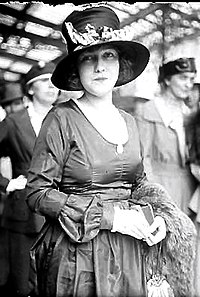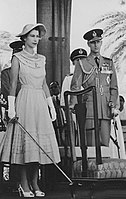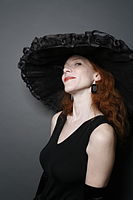
Hat-making or millinery is the design, manufacture and sale of hats and other headwear. A person engaged in this trade is called a milliner or hatter.

Lilly Daché was a French-born American milliner and fashion merchandiser. She started her career in a small bonnet shop, advanced to being a sales lady at Macy's department store, and from there started her own hat business. She was at the peak of her business career in the 1930s and 1940s. Her contributions to millinery were well-known custom-designed fashion hats for wealthy women, celebrities, socialites, and movie stars. Her hats cost about ten times the average cost of a lady's hat. Her main hat business was in New York City with branches in Paris. Later in her career she expanded her fashion line to include dresses, perfume, and jewelry.
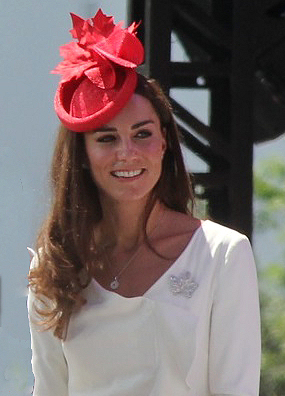
A fascinator is a formal headpiece, a style of millinery. Since the 1990s, the term has referred to a type of formal headwear worn as an alternative to the hat; it is usually a large decorative design attached to a band or clip. In contrast to a hat, its function is purely ornamental: it covers very little of the head and offers little or no protection from the weather. An intermediate form, incorporating a more substantial base to resemble a hat, is sometimes called a hatinator.
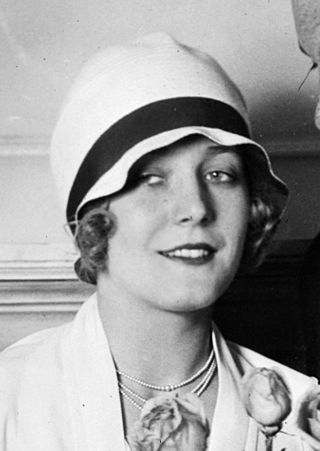
The cloche hat or simply cloche is a fitted, bell-shaped hat for women that was invented in 1908 by milliner Caroline Reboux. They were especially popular from about 1922 to 1933. Its name is derived from cloche, the French word for "bell".

Caroline Reboux was a Parisian milliner and French fashion designer. She opened her first boutique at 23 rue de la paix in Paris in 1865, which she continued to operate throughout her life. Reboux opened other shops in Paris and London starting in 1870. She trained other milliners who became famous in their own right, including American milliner Lilly Daché and French milliner Rose Valois. Reboux's most famous shop was located at 9 Avenue Matignon in Paris, which carried on operating after her death for almost three decades under the direction of Lucienne Rabaté known as "Mademoiselle Lucienne" the most famous parisian milliner at that time.

Simone Mirman (1912–2008) was a Paris-born milliner based in London, chiefly known for her designs for the British royal family.
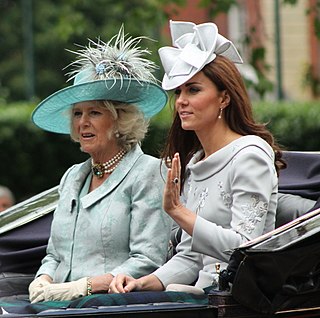
A picture hat or Gainsborough hat is an elaborate woman's hat with a wide brim. It has been suggested that the name may be derived from the way the broad brim frames the face to create a "picture".

A Breton is a woman's hat with a round crown and a deep brim that is turned upwards all the way round, exposing the face. Sometimes the hat has a domed crown. Typically it is worn tilted to the back of the head.

A halo hat is a millinery design in which the headgear acts as a circular frame for the face, creating a halo effect. The design is said to date back to the late 19th century, when it was known as the aureole hat; this name is sometimes still used. It may also be known as the angel hat or bambini – the latter said to derive from Italian for terracotta plaques depicting the infant Christ.

A cartwheel hat is a hat with a wide-brimmed circular or saucer-shaped design. It may be made in a variety of materials, including straw or felt and usually has a low crown. It may be similar to the picture hat and halo-brimmed hat in shape. Typically, it is worn at an angle to show off the curve of the brim, rather than being worn at the back of the head in the manner of a halo hat.
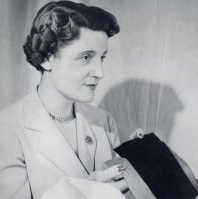
For the French general and diplomat, see Claude Carra Saint-Cyr

A half hat is a millinery design in which the hat covers part of the head. Generally, the design is close-fitting, in the manner of the cloche, and frames the head, usually stopping just above the ears. It may be similar to a halo hat in the way that it frames the face and can be worn straight or at an angle.
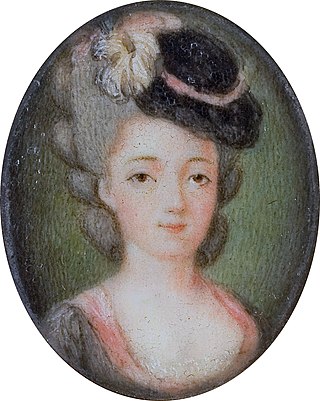
A doll hat is a women's millinery design scaled down to suggest a hat that could be worn by a doll. It can be of any design and is generally worn at the front of the head. The hat is usually held in place with a band of fabric or elastic secured at the back of the head.

A lampshade hat is a millinery design in which the hat has a small circular crown – typically flat, but sometimes rounded – and flares outwards to create a cone-like profile. In shape, it may have some similarities to the pillbox and bucket hat, both of which were popular at around the same time, although the classic lampshade design is longer and more flared than a pillbox and is generally made of stiffer material than a bucket hat.

A peach basket hat is a millinery design that resembles an upturned country basket of the style typically used to collect fruit. Generally it is made of straw or similar material and it often has a trimming of flowers and ribbons. Some models may also feature a veil or draped fabric covering. It was introduced in around 1908 and caused some controversy over the succeeding year due to its extreme dimensions and decorations. It had revivals – designs were at this stage more modest – in the 1930s and 1950s.

The tam is a millinery design for women based on the tam o' shanter military cap and the beret. Sometimes it is also known as a tam cap or the traditional term tam o'shanter might also be used. The tam became popular in the early 1920s, when it followed the prevailing trends for closer-fitting hats that suited shorter hairstyles and for borrowing from men's fashion; other traditional men's hats that rose to popularity in women's fashion during this period included the top hat and bowler. In the British Isles, the tam cap is often used as a headcovering by Christian women during church services.

A bumper brim is a millinery feature in which the hat brim is tubular in design, making it a prominent feature of the hat. In order to achieve this effect, the brim may be rolled, stiffened or padded. A bumper brim can be added to a variety of hat designs, from small to large.

A Eugénie hat is a small women's hat that is usually worn tilted forwards over the face, or it may be angled low over one eye. Typically, it is made of velvet or felt, although a variety of materials may be used. The classic design also has a plume of feathers, although other trims may be used.
Reed Crawford (1924-2006) was a British milliner of the 1950s and 1960s. He produced a series of high-fashion designs that matched the Swinging London mood of the 1960s, including helmet-style cloche hats and designs in unusual material combinations, such as plastic and fur. He became especially associated with couture, working with the designer John Cavanagh from 1959 and joining the Incorporated Society of London Fashion Designers as an associate member from 1961.

A bicycle clip hat is a style of small hat or millinery decoration that includes a metal clip – similar to traditional designs used by cyclists – to hold it in place. It may be very similar to a half hat or fascinator in design, covering only part of the head.
